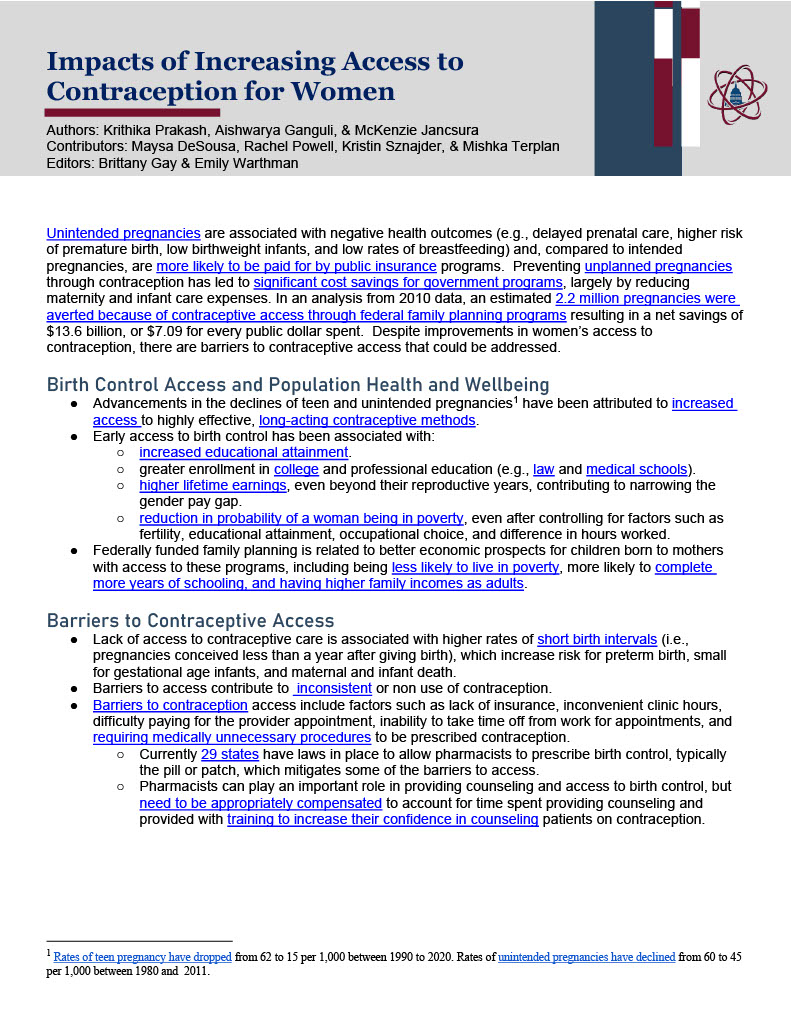
Unintended pregnancies are associated with negative health outcomes (e.g., delayed prenatal care, higher risk of premature birth, low birthweight infants, and low rates of breastfeeding) and, compared to intended pregnancies, are more likely to be paid for by public insurance programs. Preventing unplanned pregnancies through contraception has led to significant cost savings for government programs, largely by reducing maternity and infant care expenses. In an analysis from 2010 data, an estimated 2.2 million pregnancies were averted because of contraceptive access through federal family planning programs resulting in a net savings of $13.6 billion, or $7.09 for every public dollar spent. Despite improvements in women’s access to contraception, there are barriers to contraceptive access that could be addressed.
Birth Control Access and Population Health and Wellbeing
- Advancements in the declines of teen and unintended pregnancies [1] have been attributed to increased access to highly effective, long-acting contraceptive methods.
- Early access to birth control has been associated with:
- increased educational attainment.
- greater enrollment in college and professional education (e.g., law and medical schools).
- higher lifetime earnings, even beyond their reproductive years, contributing to narrowing the gender pay gap.
- reduction in probability of a woman being in poverty, even after controlling for factors such as fertility, educational attainment, occupational choice, and difference in hours worked
- Federally funded family planning is related to better economic prospects for children born to mothers with access to these programs, including being less likely to live in poverty, more likely to complete more years of schooling, and having higher family incomes as adults.
Barriers to Contraceptive Access
- Lack of access to contraceptive care is associated with higher rates of short birth intervals (i.e., pregnancies conceived less than a year after giving birth), which increase risk for preterm birth, small for gestational age infants, and maternal and infant death.
- Barriers to access contribute to inconsistent or non use of contraception.
- Barriers to contraception access include factors such as lack of insurance, inconvenient clinic hours, difficulty paying for the provider appointment, inability to take time off from work for appointments, and requiring medically unnecessary procedures to be prescribed contraception.
- Currently 29 states have laws in place to allow pharmacists to prescribe birth control, typically the pill or patch, which mitigates some of the barriers to access.
- Pharmacists can play an important role in providing counseling and access to birth control, but need to be appropriately compensated to account for time spent providing counseling and provided with training to increase their confidence in counseling patients on contraception.
Over the Counter (OTC) Access to Contraception
- Interest in OTC birth control
- Women have expressed the desire for OTC birth control pill options.
- OTC access to the pill is also backed by American College of Obstetricians and Gynecologists (ACOG) and American Academy of Family Physicians (AAFM).
- The FDA approved the first nonprescription daily oral contraceptive called Opill (progesterone only oral contraceptive, equivalent to the “minipill”) in July 2023.
- Impacts of OTC birth control
- Studies indicate that provision of OTC contraceptive access can potentially lead to improved initiation and continued use of contraceptives compared to contraceptives obtained with a prescription from a provider.
- OTC access is associated with reduced inequities in contraceptive care access, as it removes barriers such as taking time off work to see a provider or requiring insurance.
- Additional considerations
- Minimizing consumer costs for OTC oral contraceptives, such that they are similar to the current costs of prescription oral contraceptives, is of concern to women and providers.
- Women have demonstrated accuracy in identifying risk and benefits for oral contraceptive use.
- Studies have shown women are able to identify medication situations (i.e., contraindications [2]) for which oral contraceptives should not be used at the same rate as providers.
_________________
- Rates of teen pregnancy have dropped from 62 to 15 per 1,000 between 1990 to 2020. Rates of unintended pregnancies have declined from 60 to 45 per 1,000 between 1980 and 2011.
- Previous studies show 2-18% of the population has a contraindication for combined hormone type birth control pill. Only 1-2% of the population has a contraindication for the progesterone only pill.
The Research-to-Policy Collaboration (RPC) works to bring together research professionals and public officials to support evidence-based policy. Please visit their website to learn more.
Key Information
RPC Website
Research-to-Policy Collaboration
Publication DateApril 24, 2024
Topic Area(s)Health
Resource TypeWritten Briefs
Share This Page
Unintended pregnancies are associated with negative health outcomes (e.g., delayed prenatal care, higher risk of premature birth, low birthweight infants, and low rates of breastfeeding) and, compared to intended pregnancies, are more likely to be paid for by public insurance programs. Preventing unplanned pregnancies through contraception has led to significant cost savings for government programs, largely by reducing maternity and infant care expenses. In an analysis from 2010 data, an estimated 2.2 million pregnancies were averted because of contraceptive access through federal family planning programs resulting in a net savings of $13.6 billion, or $7.09 for every public dollar spent. Despite improvements in women’s access to contraception, there are barriers to contraceptive access that could be addressed.
Birth Control Access and Population Health and Wellbeing
- Advancements in the declines of teen and unintended pregnancies [1] have been attributed to increased access to highly effective, long-acting contraceptive methods.
- Early access to birth control has been associated with:
- increased educational attainment.
- greater enrollment in college and professional education (e.g., law and medical schools).
- higher lifetime earnings, even beyond their reproductive years, contributing to narrowing the gender pay gap.
- reduction in probability of a woman being in poverty, even after controlling for factors such as fertility, educational attainment, occupational choice, and difference in hours worked
- Federally funded family planning is related to better economic prospects for children born to mothers with access to these programs, including being less likely to live in poverty, more likely to complete more years of schooling, and having higher family incomes as adults.
Barriers to Contraceptive Access
- Lack of access to contraceptive care is associated with higher rates of short birth intervals (i.e., pregnancies conceived less than a year after giving birth), which increase risk for preterm birth, small for gestational age infants, and maternal and infant death.
- Barriers to access contribute to inconsistent or non use of contraception.
- Barriers to contraception access include factors such as lack of insurance, inconvenient clinic hours, difficulty paying for the provider appointment, inability to take time off from work for appointments, and requiring medically unnecessary procedures to be prescribed contraception.
- Currently 29 states have laws in place to allow pharmacists to prescribe birth control, typically the pill or patch, which mitigates some of the barriers to access.
- Pharmacists can play an important role in providing counseling and access to birth control, but need to be appropriately compensated to account for time spent providing counseling and provided with training to increase their confidence in counseling patients on contraception.
Over the Counter (OTC) Access to Contraception
- Interest in OTC birth control
- Women have expressed the desire for OTC birth control pill options.
- OTC access to the pill is also backed by American College of Obstetricians and Gynecologists (ACOG) and American Academy of Family Physicians (AAFM).
- The FDA approved the first nonprescription daily oral contraceptive called Opill (progesterone only oral contraceptive, equivalent to the “minipill”) in July 2023.
- Impacts of OTC birth control
- Studies indicate that provision of OTC contraceptive access can potentially lead to improved initiation and continued use of contraceptives compared to contraceptives obtained with a prescription from a provider.
- OTC access is associated with reduced inequities in contraceptive care access, as it removes barriers such as taking time off work to see a provider or requiring insurance.
- Additional considerations
- Minimizing consumer costs for OTC oral contraceptives, such that they are similar to the current costs of prescription oral contraceptives, is of concern to women and providers.
- Women have demonstrated accuracy in identifying risk and benefits for oral contraceptive use.
- Studies have shown women are able to identify medication situations (i.e., contraindications [2]) for which oral contraceptives should not be used at the same rate as providers.
_________________
- Rates of teen pregnancy have dropped from 62 to 15 per 1,000 between 1990 to 2020. Rates of unintended pregnancies have declined from 60 to 45 per 1,000 between 1980 and 2011.
- Previous studies show 2-18% of the population has a contraindication for combined hormone type birth control pill. Only 1-2% of the population has a contraindication for the progesterone only pill.
The Research-to-Policy Collaboration (RPC) works to bring together research professionals and public officials to support evidence-based policy. Please visit their website to learn more.

Key Information
RPC Website
Research-to-Policy Collaboration
Publication DateApril 24, 2024
Topic Area(s)Health
Resource TypeWritten Briefs
Share This Page
LET’S STAY IN TOUCH
Join the Evidence-to-Impact Mailing List
Keep up to date with the latest resources, events, and news from the EIC.




